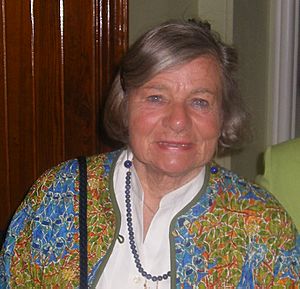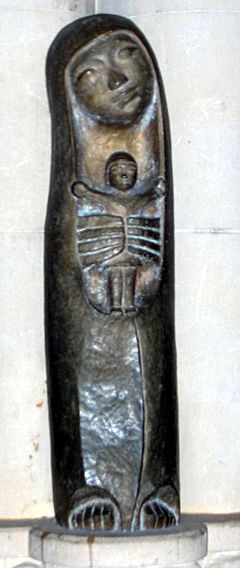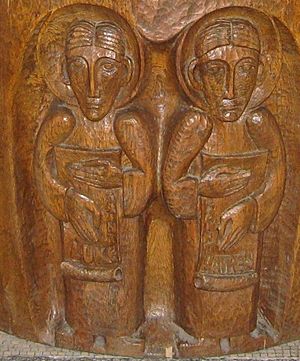Imogen Stuart facts for kids
Quick facts for kids
Imogen Stuart
|
|
|---|---|

Imogen Stuart in 2011
|
|
| Born |
Imogen Werner
25 May 1927 |
| Died | 25 March 2024 (aged 96) |
| Occupation | Sculptor |
Imogen Stuart (born Imogen Werner; May 25, 1927 – March 25, 2024) was a famous German-Irish sculptor. She was known as one of Ireland's most important sculptors. Her amazing artwork can be found in many places, both public and private, across Europe and the United States.
In 2010, President Mary McAleese gave Imogen Stuart the Mary McAuley medal. The President praised her "genius" and said her work brought together Ireland's past, present, and future. She called Stuart a key part of modern Irish art.
Contents
Early Life and Artistic Journey
Imogen Werner was born in Berlin, Germany, on May 25, 1927. Her father, Bruno E. Werner, was an art critic and writer. He encouraged her love for art from a young age. Imogen grew up in Berlin during World War II. She started drawing and sculpting when she was young. Her father helped her by supporting artists through his magazine, die neue linie.
In 1945, after the war, Imogen began studying art with Otto Hitzberger. He taught her how to model, carve, and create relief art using different materials. In 1948, she met Ian Stuart, an Irishman, who was also studying with Hitzberger. Ian was the grandson of Maud Gonne, a famous Irish revolutionary.
Moving to Ireland
In 1949, Imogen and Ian moved to Ireland. They got married in 1951 and made their home in Laragh Castle, near Glendalough. Imogen Stuart became a very important artist in Ireland.
In 2015, she was given a special honor called Saoi by the Aosdána. This is the highest honor for Irish artists. Imogen Stuart passed away on March 25, 2024, at the age of 96.
Imogen Stuart's Sculptures

Imogen Stuart worked with many different materials. These included wood, bronze, stone, steel, clay, and terracotta. She created many sculptures for both Roman Catholic and Church of Ireland churches. Her art can be seen all over Ireland.
Some of her most famous church works include:
- A large sculpture of Pope John Paul II at St. Patrick's College, Maynooth.
- The beautifully carved altar in the Honan Chapel in Cork.
Art Beyond Churches
Stuart's work was not only for churches. She also created art for other important places. For example, she made a bust (a sculpture of someone's head and shoulders) of former President Mary Robinson. This sculpture is now at Áras an Uachtaráin, which is the official home of the President of Ireland in Dublin.
She also created the Flame Of Human Dignity at the Centre Culturel Irlandais in Paris. Imogen Stuart also designed collections of silver, gold, and bronze jewelry. She made drawings and large sculptures from wood, stone, concrete, and other materials.
Imogen Stuart once said about her work: "I learned to develop a great freedom of expression. My life is full of gifts or minor miracles. I never intellectualize – the eyes and senses dictate my hands directly." This means she let her feelings and senses guide her hands when she created art.
A book about her life and work was published in 2002. It included writings by art critic Brian Fallon and historian Peter Harbison. You can also find one of her sculptures in the town square of Ballymore Eustace, County Kildare.
Art at Mary Immaculate College
In 1958, the Sisters of Mercy asked Imogen Stuart to create three major art pieces for them. Over time, more of her artworks were added to the collection at Mary Immaculate College. Today, 15 of Imogen's pieces are on display there for everyone to see.
Awards and Honors
Imogen Stuart was a professor of sculpture at the Royal Hibernian Academy in Dublin. She was also a member of Aosdána, a group that honors Irish artists.
She received special honorary doctorates from several universities:
- Trinity College Dublin (2002)
- University College Dublin (2004)
- NUI Maynooth (2005)


